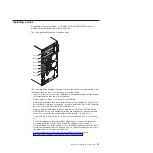
Power
and
signal
cables
for
internal
drives
The
server
uses
cables
to
connect
parallel
IDE,
simple-swap
SATA,
and
SAS
devices
to
the
power
supply
and
to
the
system
board.
(See
for
the
location
of
system-board
connectors.)
Review
the
following
information
before
you
connect
power
and
signal
cables
to
internal
drives:
v
The
drives
that
are
preinstalled
in
the
server
come
with
power
and
signal
cables
attached.
If
you
replace
any
drives,
remember
which
cable
is
attached
to
which
drive.
v
When
you
install
a
drive,
make
sure
that
one
of
the
signal
cable
drive
connectors
is
connected
to
the
drive
and
that
the
connector
at
the
other
end
of
the
signal
cable
is
connected
to
the
system
board
or
a
compatible
adapter
or
controller
that
you
have
installed.
v
If
you
have
only
one
IDE
device
on
a
cable,
it
must
be
set
as
a
master
device.
v
If
two
IDE
devices
are
used
on
a
single
cable,
one
must
be
designated
as
the
master
device
and
the
other
as
the
subordinate
device;
otherwise,
the
server
might
not
recognize
some
of
the
IDE
devices.
The
master
and
subordinate
designation
is
determined
by
switch
or
jumper
settings
on
each
IDE
device.
v
When
you
route
a
cable,
make
sure
that
it
does
not
block
the
airflow
to
the
rear
of
the
drives
or
over
the
microprocessor
or
DIMMs.
The
following
cables
are
provided:
v
Power
cables:
Four-wire
power
cables
connect
the
drives
to
the
power
supply.
At
the
end
of
these
cables
are
plastic
connectors
that
can
be
attached
to
different
drives;
these
connectors
vary
in
size.
Use
either
a
four-wire
power
cable
or
SATA
power
cable
with
SATA
drives,
but
do
not
use
both
at
the
same
time
(use
one
or
the
other).
v
Signal
cables:
Signal
cables
are
typically
flat
cables,
also
called
ribbon
cables,
that
connect
parallel
IDE,
SATA,
SAS,
and
diskette
drives
to
the
system
board.
Two
or
three
types
of
signal
cables
come
with
the
server:
–
IDE:
The
wider
IDE
signal
cable
has
three
connectors.
One
of
these
connectors
is
attached
to
the
drive,
one
is
a
spare,
and
the
third
is
attached
to
the
primary
or
secondary
IDE
connector
on
the
system
board.
The
spare
connector
can
be
used
to
connect
an
additional
IDE
drive
to
the
server.
The
CD
drive
is
attached
to
an
ATA
100
signal
cable.
ATA
100
signal
cables
are
color-coded.
The
blue
connector
is
attached
to
the
system
board.
The
black
connector
is
attached
to
the
master
IDE
device.
The
gray
middle
connector
is
attached
to
the
subordinate
IDE
device.
–
(Optional)
Diskette
drive:
The
narrower
signal
cable
has
two
connectors.
One
is
attached
to
the
diskette
drive,
and
the
other
is
attached
to
the
connector
(FDD1)
on
the
system
board.
–
Simple-swap
SATA:
Simple-swap
SATA
models
come
with
four
SATA
cables
that
are
already
connected
to
the
system
board
and
the
back
panel
at
the
rear
of
the
simple-swap
drives.
–
Hot-swap
SATA:
Hot-swap
SATA
models
come
with
a
single
data
cable
that
connects
the
SAS/SATA
controller
to
the
hot-swap
backplane.
This
cable
provides
inherent
connectivity
for
the
four
SATA
drives
that
the
server
supports.
Therefore,
additional
cabling
is
not
required
for
these
drives.
–
SAS:
Hot-swap
SAS
models
come
with
a
single
data
cable
that
connects
the
SAS/SATA
controller
to
the
hot-swap
backplane.
This
cable
provides
inherent
connectivity
for
the
four
SAS
drives
that
the
server
supports.
Therefore,
additional
cabling
is
not
required
for
these
drives.
Chapter
2.
Installing
optional
devices
35
Summary of Contents for System x3200 4362
Page 1: ...System x3200 Types 4362 and 4363 User s Guide...
Page 2: ......
Page 3: ...System x3200 Types 4362 and 4363 User s Guide...
Page 81: ...Web site continued Update Xpress program 7 weight 3 Index 67...
Page 82: ...68 System x3200 Types 4362 and 4363 User s Guide...
Page 83: ......
Page 84: ...Part Number 42D2453 Printed in USA 1P P N 42D2453...
















































